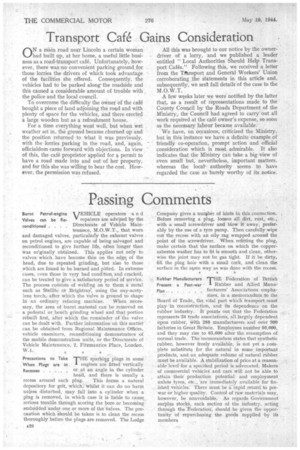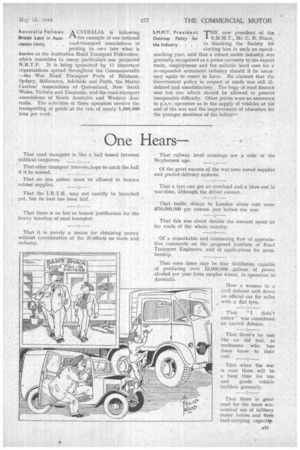Passing Comments
Page 22

Page 23

If you've noticed an error in this article please click here to report it so we can fix it.
Burnt Petrol-engine VEHICLE operators a n d Valves can be ReV repairers are advised by the conditioned . . Directorate of Vehicle Main
tenance, M.O.W.T„. that worn and damaged valves, particularly the exhaust valves on petrol engine, are capable of being salvaged and reconditioned to give further life, often longer than was originally obtained. This applies not only to valves 'which, have become thin on the edged, of the head, due to repeated grinding, but also to those .which are found to be burned and pitted. In extreme cases, even those in very bad condition, and cracked, can be treated to give a satisfactory period of service. The process consists of welding on to them a metal such as Stellite or BrightraY, using the oxy-acetylene torch, after which the valve is ground to shape in an ordinary refacing machine. When necessary, the area of burnt .material can be removed on a pedestal or benth grinding wheel and that portion rebuilt first, after which the remainder of the valve can be dealt with. Further information oh this matter can be obtained from Regional Maintenance Offices, vehicle examiners, reconditioning demonstrators of the mobile demonstration units, or the' Directorate of Vehicle Maintenance, 2, Fitzrnaurice Place, London, W:l.
THE sparkqg plugs in some engines are fitted vertically. or at an angle in the cylinder head, and there is usually a
recess around each plug. This forms a natural depository for grit, which, whilst it can do no harm unless disturbed, may fall into a cylinder when a plug is removed, in which case it is liable to cause serious trouble through scoring the bore or becoming embedded under one or more of the valves. The precaution which should 'be taken is to clean the recess thoroughly before the plugs are removed. The Lodge A20 Precautions to Take When Plugs are in Recesses . . .
Company gives a nun-ober of hints in this connection. . Before removing a plug, loosen all dirt, rust, etc., with a small Screwdriver and blow it away, preferably by the use of a tyre pump. Then carefully wipe out the recess with an oily rag wrapped around the point of the screwdriver. When refitting the plug, make certain that the surface on which the copperasbestos washer has to fit is smooth and clean, otherwise the joint may not be gas tight. H it be dirty; fill the plug hole with a small cork, and clean the surface in the sarne.way as was done with the recess.
Rubber Manufacturers 'THE Federation of British Present. a Post-war 1 Rubber and Allied Manu
Plan • facturers' Associations empha
sizes, in a memorandum to the Board of Trade, the, vital part which transpornmust play in reconstruction, and its dependence on the rubber industry. It points out that the Federation represents 24 trade associations, all largely dependent upon rubber, with 288 manufacturers and over 300 factcsries in Great Britain. Employees number 50,000, and they may rise to 65,000 after the resumption of normal trade. The memorandum states that synthetic rubber, however freely available, is not yet a coinplete substitute for the natural in some important products, and an adequate volume of natural rubber must be available. A stabilization of price at a reasonable level for a specified period is advocated, Makers of commercial vehicleS and cars will not be able to attain their production potential and employment unleSs tyres, etc., 'are immediately available for finished vehicles. There must be a rapid returri to prewar or higher quality. Control of raw materials may, however, be unavoidable. As regards GoVernment surplus stocks, each section of the industry, acting through the Federation, should be given the opportunity of .repurchasing the goods supplied -by its members A uSTRALIA is following the example of our national road-transport associations in pooling its own into what is known as the Australian Road Transport Federation, which resembles in many particulars our projected N.R.T.F. It is being sponsored by 11 important organizations spread throughout the Commonwealth —the War Road Transport Pools of Brisbane, Sydney, Melbourne, Adelaide and Perth, the Master Carriers' Associations of Queensland, New South Wales, Victoria and Tasmania, and the road-transport associations of South Australia and Western Australia. The activities. of these operators involve the transporting of goods at the rate of nearly 1,000,000 tons per week.
ciation Unity . .
s.m.m.T. President Fr'HE new president of the
Outlines Policy for S.M.M.T., Mr. C. B. Nixon, the Industry . . . . in thanking the Society for electing him in such an epoch marking year, said that a robust motor industry was generally recognized as a prime necessity to the export trade, employment and the suitable hard core for a re-expanded armament industry should it be necessary again to resort to force. He claimed that the Government policy in respect of roads was still illdefined and unsatisfactory. The bogy of road finance was not one which should be allowed to present insuperable difficulty. Other points were an assurance to p.s.v operators as to the supply of vehicles at the end of the war and the improvement of education for the younger members of the industrY




























































